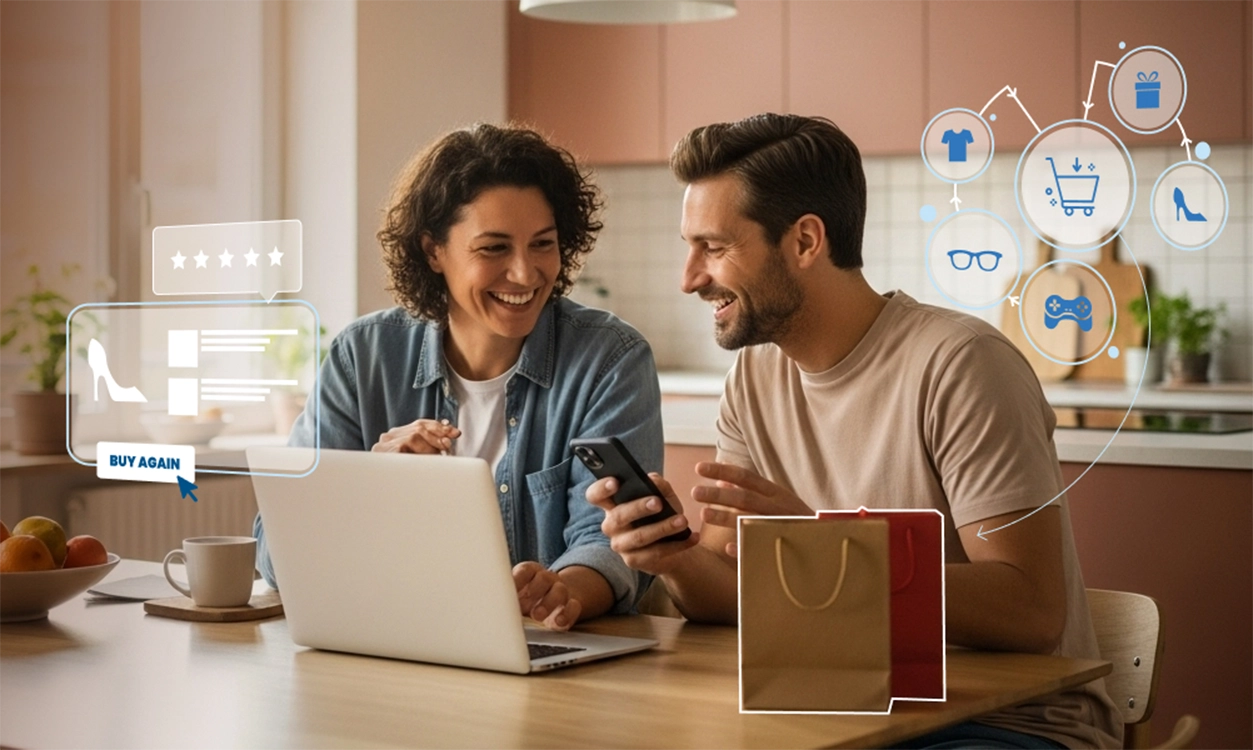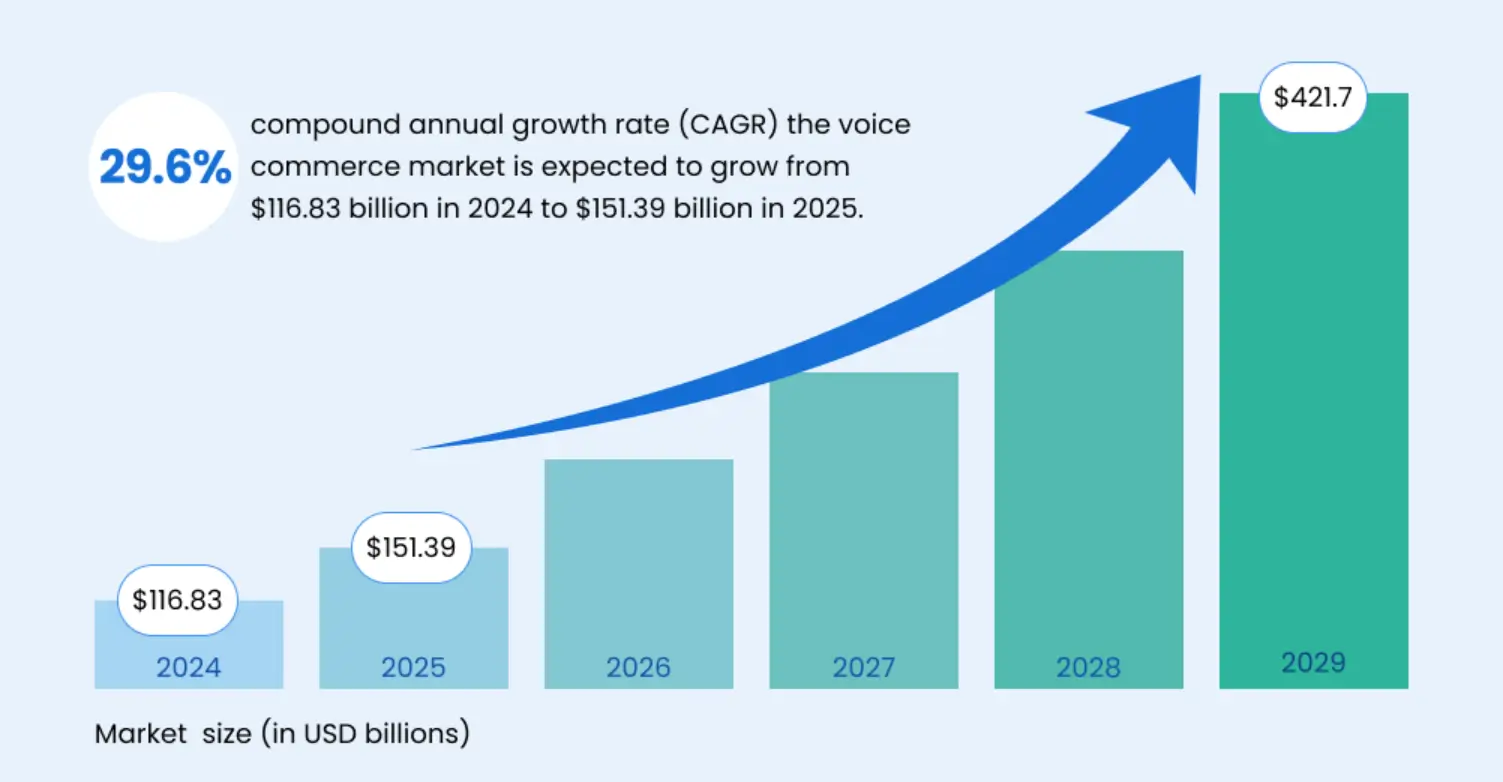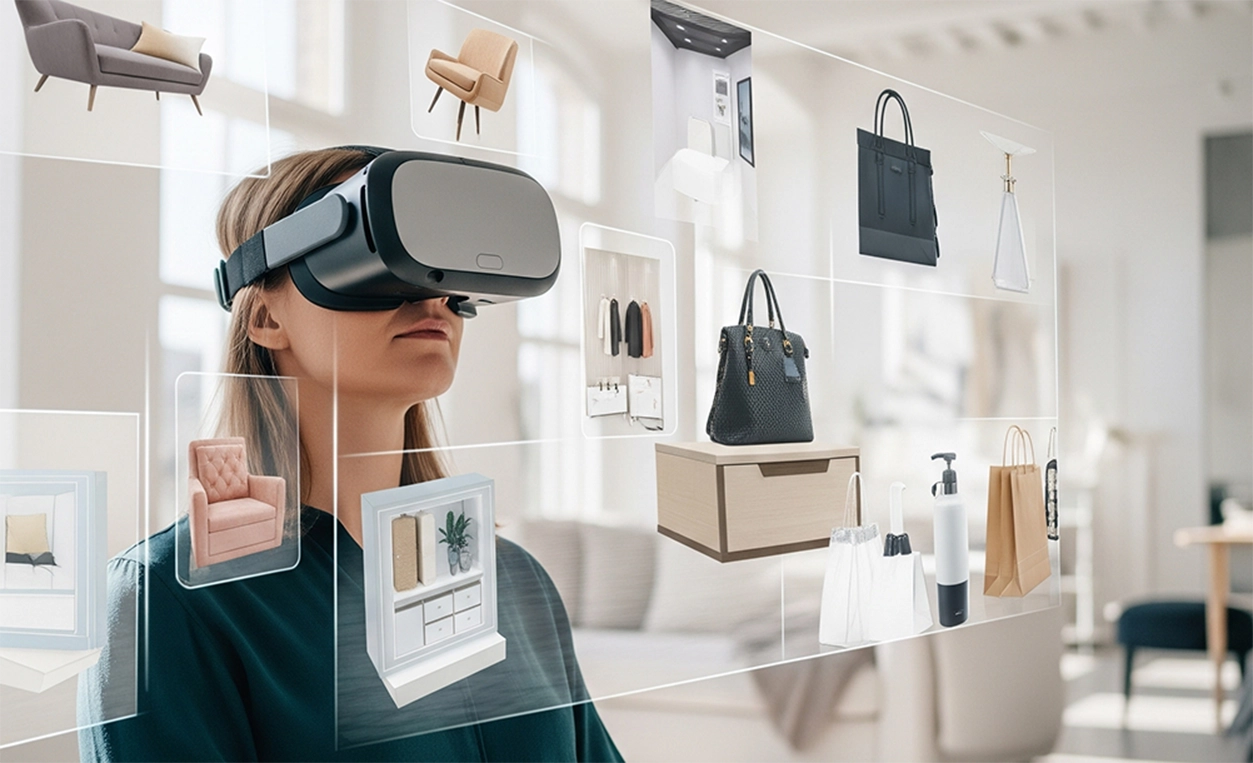Competition among retailers is gaining momentum in 2025. Driven by new technologies and often unpredictable changes in customer behavior, challenges are only expected to become more complex as the e-commerce market expands. Let’s talk numbers: the online segment is predicted to cover up to 21 percent of total global retail sales by 2029, exceeding 10 trillion US dollars, according to Statista.
Considering the speed of the e-commerce industry growth, tech innovations are no longer optional. Strategies like omnichannel retail, AI-powered personalization, or frictionless payment options like BNPL are now among the key things large retailers should adopt in order to stay competitive. No worries if any of those still don’t sound too familiar though. We are here to guide you through the most recent e-commerce industry trends that are going to shape the future of large retail.
How will e-commerce trends transform retail in 2025 and beyond? What are the key trends driving e-commerce growth? What challenges should large retailers be ready for to win the competition? Let’s break it down and identify the strategic opportunities for your business.

Latest E-commerce Trends 2025
-
1
Omnichannel
An omnichannel strategy in enterprise retail is one of the key factors impacting customer retention. The research by CapitalOne has revealed — businesses that chose an omnichannel approach to their sales manage to retain 90 percent more consumers compared to the stores that are still operating under a single-channel strategy.
Moreover, retailers who use more than two channels see a 250 percent uplift in customer engagement compared to their single-channel competitors. Impressive numbers, right? If set up properly, an omnichannel approach allows increasing your customers' lifetime value (LTV), satisfaction rates, and refining operations for your business.
So, what is omnichannel retail?
Imagine a customer who is browsing your website, checking product availability at your offline stores, and then choosing to have the item delivered to their preferred location to complete the purchase in person. At every stage of their journey, they receive consistent pricing, access to promos, and the level of service. This is omnichannel — a retail strategy designed to deliver a seamless, integrated experience for customers across every touchpoint of their interaction with your store.
Key challenge for retailers here is hidden in the description — consistency of experience. Meaning, having reliable digital solutions that allow managing cross-platform changes, tracking user behavior patterns, supporting orders, and payments across every touchpoint. At Hootcore, we’ve built a smart PIM (Product Information Management) system that makes it easy to manage and share detailed product data across all your sales channels. It keeps everything consistent, accurate, and ready to scale.
-
2
AI-Driven Personalization
The logical continuation of the Omnichannel trend. Experts from McKinsey state that global retail is moving towards the “phygital” era — where there is no division into the physical and digital world in retail. Instead, we will have a completely connected and hyper-personalized experience. Customers already expect businesses to approach them as individuals — not just as “similar buyers”, — with offers tailored to their unique needs.
If previously AI-driven personalization was used to customize targeted offers, now it provides outstanding opportunities for e-commerce. From deeply personalized shopping experiences and tailored recommendations to dynamic content, and offers. Experts say retailers who approach personalization in a smart way could potentially save up to 20 percent on their marketing costs. Not to mention the increase in their customer’ loyalty levels and lift in total sales.
-
3
Composable Commerce
This trend is really about transforming tech challenges into opportunities. In simple words, composable commerce is when e-commerces use various modules to support shopping experience instead of having one monolithic system. Think of it as creating your perfect tech stack with LEGO blocks, such as shopping carts, payment gateways, content management systems, etc.
This approach provides unprecedented flexibility and allows enterprise businesses to scale and customize way more efficiently. For example, Sephora has adopted a composable architecture back in 2022, integrating specialized services for product information management, order management, and customer data, as the result, integration allowed them to launch new features four times faster.
-
4
Flexible Payment
According to a recent study, 13 percent of clients wouldn’t proceed with their order if they don’t have enough payment options at the checkout. Yet, offering multiple payment methods (like electronic wallets, Google and Apple pay) are not enough in 2025. Customers expect large retailers to consider their local payment systems and, what’s more, to allow them not to pay at check out at all.
BNPL — many of you are already familiar with these four letters, which stand for the Buy Now Pay Later experience. If your buyers could order online, especially apparel or electronic goods, try them at home and then pay — you’re going to see a brand new level of loyalty. Integrations with BNPL platforms, like Klarna, can help retailers increase their AOVs and checkout conversions.
-
5
Frictionless delivery & Reverse logistics
As the e-commerce sector continues to grow, the volume of orders and returns is rising rapidly. To win the competition in 2025 large e-commerce businesses need to provide a smooth, clear, and fast receive/return experience to their buyers. Walmart, for instance, now delivers to 95 percent of the U.S. population within three hours, helping its e-commerce division turn profitable for the first time.
On the flip side, reverse logistics is becoming a key e-commerce trend for those who’d like to stay competitive. With online orders growing, so do returns, and this trend pushes the global reverse logistics market toward $778 billion in 2025. Smart returns processes not only help improve customer satisfaction but can also save on costs. Together, these trends reflect a bigger shift: logistics is no longer just back-end support but a critical driver of customer loyalty and profitability. This is where robust order management systems become essential.
In Hootcore, for example, we offer two dedicated modules tailored to streamline fulfillment and delivery:
- The fulfillment module optimizes picking and packing processes across warehouses and production sites.
- The delivery module integrates with multiple shipping providers to automate cost estimates, parcel generation, and real-time tracking. Learn more
Powerful OMS to Streamline Your Operations
Track, manage, and fulfill every order with speed and precision — from warehouse to doorstep.
Explore OMS -
6
Subscription Business Models
It’s no secret that the global e-commerce subscription market is now also rapidly growing. Experts predict it will reach 904.28 billion US dollars by 2026. For retailers in categories like beauty, groceries, supplements, or apparel rentals, subscriptions can significantly boost customer lifetime value.
In fact, subscription customers typically generate three to five times more revenue than one-time buyers. Beyond the revenue uplift, subscriptions also provide retailers with more predictable income streams and foster stronger customer loyalty over time.
-
7
Data Privacy and Identity Verification
Yet another e-commerce trend in 2025 that businesses can’t neglect is related to data privacy. Things like identity verification and data security are no longer compliance checkboxes — they act as core pillars that help you gain your customers’ trust and ensure operational resilience.
Concerns over data breaches are only growing among people, as a result – global regulations like the GDPR are becoming even tighter. Consider your consumers' awareness of how their personal information is handled tends to increase. For instance, 79% of buyers say they’re more likely to trust brands that clearly protect their data. The action point here is simple — retailers must prioritize how they collect, store, and use their customers’ data in order to stay competitive.
Advanced identity verification tools are your best friends here. Biometric authentication and AI-based fraud detection are aimed to help retailers secure transactions and reduce fraud. While implementation can be complex, the payoff is clear: way higher customer trust, alignment with regulations, and reduced exposure risks in a digital-first retail economy.
-
8
Voice Commerce
The market of voice commerce continues to gain its momentum, reaching 150 billion US dollars in 2025. The number of active voice assistant devices has already crossed the 8 billion mark, and recent data states that almost 50 percent of the US consumers are using voice search for shopping. With smart speakers becoming household staples, enterprise retailers should proactively consider the integration of voice-activated shopping for their digital ecosystems. Put simply, more and more consumers will be asking their voice assistants to find products, bypassing traditional web searches and screen-based browsing altogether.
Retail giants are already leveraging this technology. Below are just a few examples:
- Amazon's Alexa enables users to reorder products and receive personalized recommendations.
- Walmart has developed its own end-to-end machine learning system for personalized conversational voice models in e-commerce. The strategy allowed enhancing the shopping experience for its customers.
- Grocery retailers like Whole Foods and Walgreens offer voice shopping capabilities through Google Assistant.
Betting on voice search or voice commerce can help large retailers win the competition by increasing customer convenience. Voice search can also support faster transaction times, and enhanced personalization.

-
9
Augmented & Virtual Reality
Augmented Reality (AR) and Virtual Reality (VR) are actively becoming must-have tools rather than just trends to follow. These technologies are reshaping the way your customers browse, try, and buy your products. VR now is offering immersive experiences that go far beyond traditional e-commerce.
Take IKEA, for example. Its “Place” app lets customers see how the chosen furniture would look in their homes before they hit the “Buy” button. Approach helps reduce returns and increase confidence in purchase decision-making. Luxury apparel brand Gucci uses AR to let their shoppers virtually try on shoes. Saks Fifth Avenue is testing virtual try-ons for clothes and accessories, mixing personalization with convenience.
The upside? AR and VR can boost engagement, contribute to lowering the return rates, and offer unique ways to stand out from competitors. According to Fortune Business Insights, the AR market alone could hit $140B in 2025. The catch? Integration requires solid tech infrastructure, quality 3D assets, and user-friendly design. It’s a big investment for business but one that can bring the shopping experience for your customers to the brand new level.

-
10
Social & Influencer Commerce
Social and influencer commerce is one more exciting trend to watch in 2025. This approach allows to merge shopping experiences with social media engagement. The global social commerce market is growing three times faster than traditional e-commerce, and is projected to reach $1.2 trillion in 2025.
Global retailers are already actively using platforms like Instagram, TikTok, and Facebook to integrate shopping directly into social feeds. Your customers spend at least an hour a day surfing social media, so providing them with the opportunity to buy your goods in a convenient environment is a key.
Working with influencers and going social can help your business increase brand visibility, improve conversion rates, and contribute to a stronger customer loyalty.
-
11
M-Commerce
Mobile commerce (m-commerce) is revolutionizing retail, enabling consumers to shop seamlessly via smartphones and tablets. It's projected that m-commerce will account for 59% of total e-commerce sales, amounting to $4.01 trillion globally this year. This surge is driven by the convenience of mobile shopping, allowing customers to browse and purchase products anytime, anywhere.
Enterprise retailers are capitalizing on this trend. Vodafone, for instance, expanded its mobile commerce platform to over 1 million subscribers within a year, significantly increasing service value. Walmart has also embraced mobile-first strategies, integrating features like store mode in its app to enhance in-store shopping experiences.
The benefits of m-commerce for businesses are obvious: higher customer engagement, increased sales, and improved customer loyalty. However, your tech team should be ready to face some extra challenges, such as ensuring mobile app security, providing a seamless user experience, and managing mobile payment systems.
Conclusion
We’ve covered quite a few e-commerce trends in this article, and it’s up to retailers to decide which ones to try for their businesses. Yet the core idea, we’d like to highlight is — an outstanding shift in technologies that are only going to emerge in upcoming years. So, no matter which innovations you are following, make sure your store architecture is reliable and flexible enough to handle any integrations and experiments.
Want to see Hootcore in action?
Our team is ready to guide you, show real use cases, and help you get the most out of Hootcore.